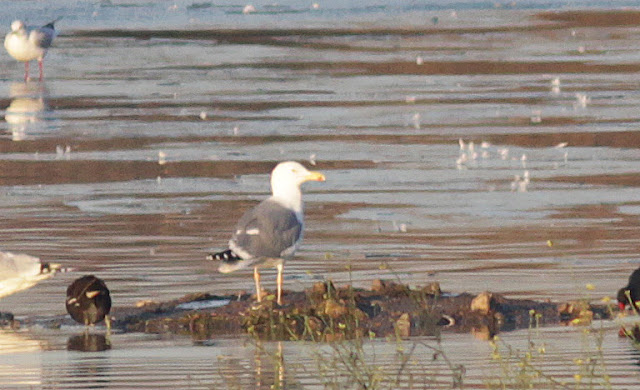It's raining and it's November so it's reminiscent time (any excuse to avoid dealing with my work back- log basically). Full finds list
HERE
10 Short-eared Owl, Beddington Farmlands 1985
Finding one of these in 1985 when I was 13 was basically a life changing event. I didn't know what it was (parents couldn't afford a field guide) and when I found out (by dustman Garry Messenbird) that it was a day flying owl - it basically blew my peasant child mind. From that day on I had to see and know everything about birds.
9 Little Egret, Beddington Farmlands 1991- A County First
Not the actual bird- 1991, a decade before affordable cameras. Wasn't keeping a notebook at the time as was 19 years old and had developed an unhealthy interest in female humans
The harbinger of local colonisation. I found this on a day off from working in Burger King. Garry Messenbird had popped into the local cafe for a fry up and by the time he'd wiped the egg from his face it was all too late. It took Garry a few years to get the bird back- now its a regular bird.
8 Pectoral Sandpiper, Beddington Farmlands 1988, a first for Beddington
Found this bird with birding guru Simon Aspinall (as in the Simon Aspinall Wildlife Education Centre in Cley
HERE). Regular birding and instruction with Simon in the late 1980's set my course for the future. This was my first Beddington first. Also over the years found several others including Fulmar, Pacific Golden Plover, Long-tailed Skua, Great Skua, Little Tern, Dartford Warbler and Serin.
7. Eastern Black Redstart, Georgia, former USSR
Dutch Birding write up on this. Found with Darryl. As far as we know- a first for Georgia??
6. Zino's Petrel- not on Madeira.
To be honest Bob Flood identified this from photos (pic above is extract from North Atlantic Seabirds) but we did find and photograph it on the Azores Pelagics (
AZORES PELAGICS), One of very few records of this species away from Madeira and one of the rarest seabirds in the world.
Supporting cast on these trips are Swinhoe's Petrels- we seem to have discovered the most regular spot for them in the WP.
MORE HERE. Also found Brown Booby and Fea's-type Petrels on these trips and other project members have found South Polar Skua.
5. Azores WP megas
Eastern Wood Pewee 2015- 2nd for WP
Hudsonian Godwit 2007- found with Simon Buckell. (photo from Marcel Haas' book)
White-crowned Sparrow 2005
Mourning Dove 2005
I'm just going to lump all these at No 5. Mega WP finds (often with Darryl) include Eastern Wood Pewee, Hudsonian Godwit (with Simon Buckell), Summer Tanager, Trindade Petrel, Hooded Warbler, Black-throated Blue Warbler and Mourning Dove. Mega here loosely means species recorded less than 10 times in the WP at the time.
COPY OF SCIENTIFIC PAPER HERE
4. Short-billed Gull- First for the WP
Early 2000s were an exciting time for gull watching in the WP. Along with Mushaq Ahmed, Sam Woods, Kate Armstrong, Claire Jones, Chris Townend and Simon Buckell we did a series of gull watching expeditions to Ireland and the Azores. It culminated in Kate and I finding a first for the WP, a Short-billed Gull, the american race (or species to some authorities) of Common Gull. We also found a stack load of American Herring Gulls on the Azores, a handful of Bonaparte's Gulls, Laughing Gull, Forster's Tern and Kumlien's Gulls in Ireland.
American Herring Gulls in the Azores 2004
American Herring Gulls etc in Azores 2003 (Birding World)
Kumlien's Gull in Ireland 2004 (notebook extract)
A very interesting discovery in 2002 was this Yellow-legged Gull at Killybegs, Ireland. Not a lot was known of Azores Gull at the time (it was thought that winter birds are always heavily streaked on the head). However on reflection this bird looks like a classic 3rd-winter Azores Gull.
3. Pacific Golden Plover, Beddington Farmlands, 2010 - first one in London since 1870
A fly-over BB rarity on the patch! and a great group identification exercise (see the article in Birdwatch).
2. It's a tie breaker with both (three even) at no 1:
1. Great Skua 1998 and Long-tailed Skua 2010 at Beddington Farmlands
Seabirds on the patch (inland in London) are mind blowing and not much beats in land Skuas!
1. White-eyed Vireo, Corvo 2005, first for the WP
Extract from Dutch Birding on write up for Corvo including pic of the 2nd one found by Darryl. My photo of the first one still goes down as one of the worst photographs ever published in birding literature. Can you re-find it (below)





































































